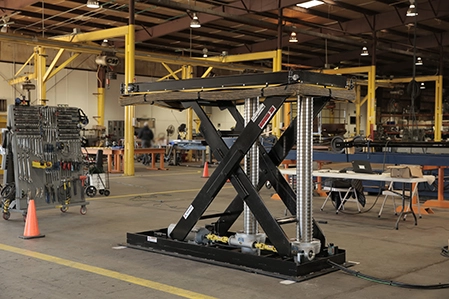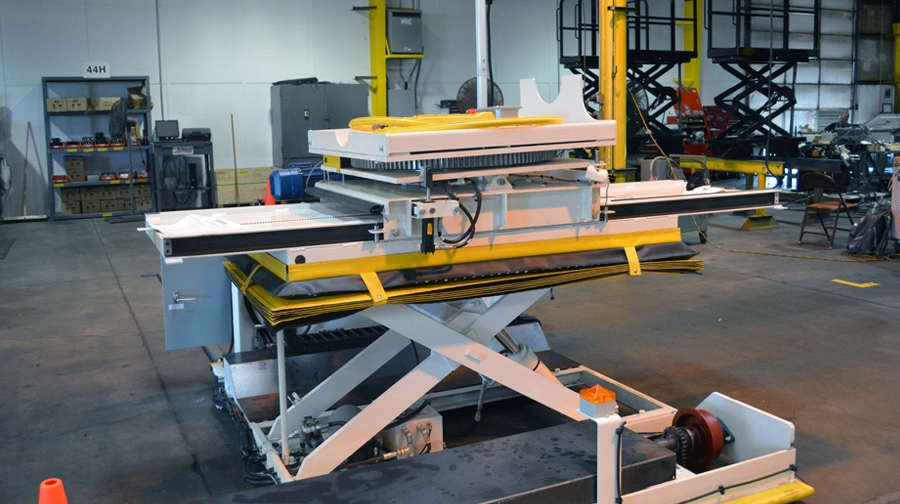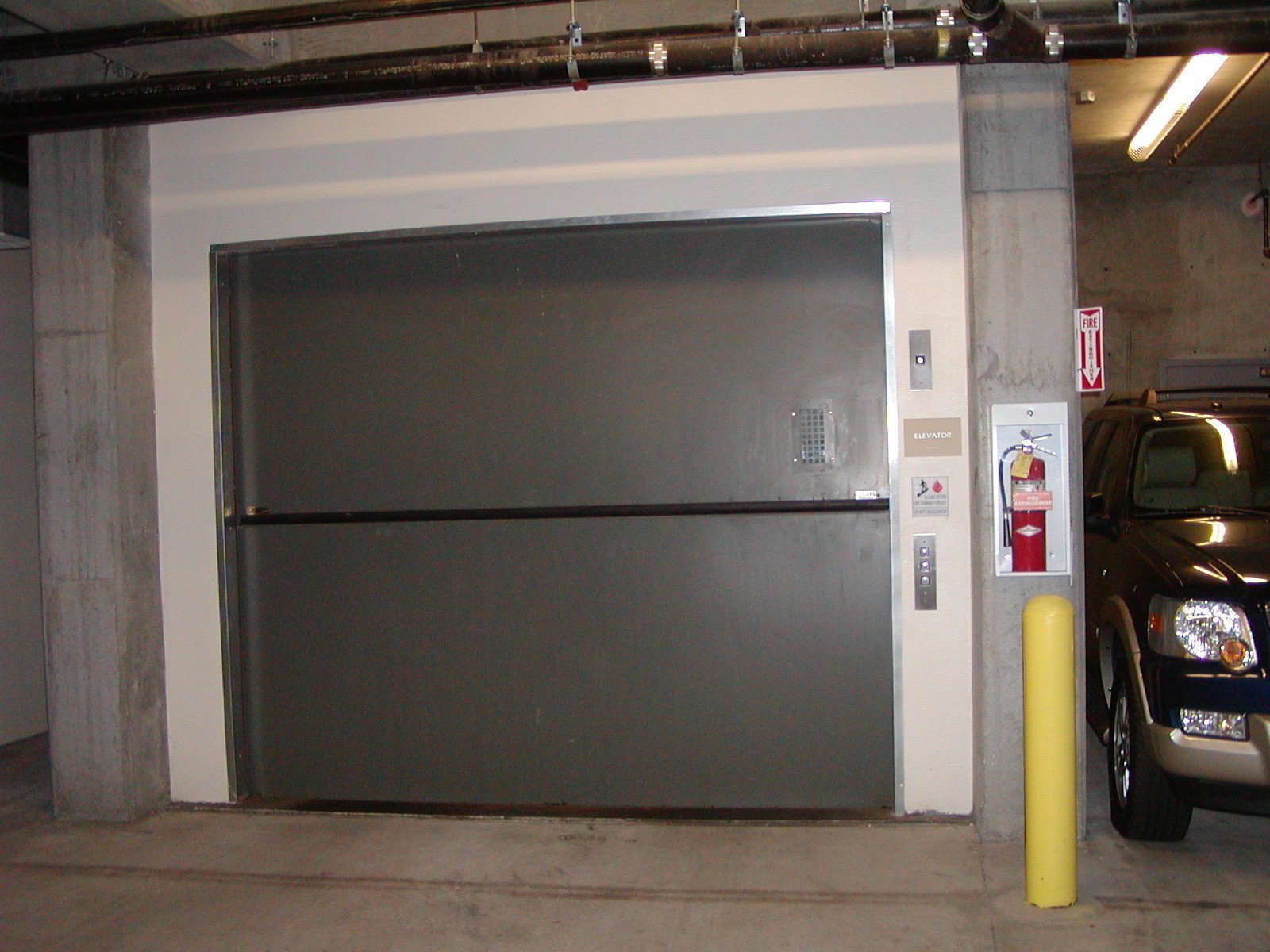Scissor lift tables, distinct from scissor lift platforms, often used for elevating personnel, are designed to lift heavy loads such as freight, equipment, tools, and parts, enhancing ergonomics and efficiency in various industrial settings. This comprehensive article explores the nuances of scissor lift tables, covering their benefits, uses, components, limitations, types, and operational mechanisms and providing insights into purchasing and selecting the correct model for specific needs.
Table of Contents:
Advantages of Scissor Lift Tables
Scissor lift tables offer numerous advantages that make them indispensable in many work environments. They enhance safety by providing a stable platform to lift and lower heavy items, reducing the risk of injuries related to lifting and moving heavy loads manually. These tables improve operational efficiency and productivity, as they can quickly and easily adjust to the desired height. Additionally, they offer versatility in various applications, ranging from manufacturing and warehousing to retail and distribution. They contribute to improved ergonomics by allowing workers to adjust the load to an optimal working height, thereby minimizing strain and fatigue.
Uses of Scissor Lift Tables
Scissor lift tables excel in many settings for lifting and positioning heavy loads. They are commonly used in manufacturing lines, for material handling in warehouses, logistics, and distribution centers for loading and unloading goods, workshops for elevating equipment and tools, and retail for stocking shelves. They also find applications in automotive repair shops, construction sites, and office environments for handling heavy files and equipment.

Components of a Scissor Lift Table
A scissor lift table comprises several key components:

- Platform: The top area where the load is placed.
- Scissor Legs: Cross-linked, collapsible pantograph structure that expands and contracts to lift or lower the platform.
- Base Frame: The bottom part of the table that provides stability.
- Lifting Mechanism: A hydraulic cylinder, pneumatic actuator (airbags), or electro-mechanical device to raise and lower the lift.
- Control Unit: Allows the operator to adjust the height of the platform.
- Safety Features: Guardrails, safety valves, and limit switches may be included to prevent overloading and ensure safe operation.
Limitations of Scissor Lift Tables
While scissor lift tables are highly beneficial, they have limitations. The height and weight capacity are finite, necessitating proper selection to meet specific needs. They require maintenance to keep their lifting mechanisms in working order. Moreover, they occupy space even when not in use, which could be a constraint in tight spaces.
Types of Scissor Lift Tables
There are several types of scissor lift tables, including:
- Hydraulic Scissor Lift Tables: Use hydraulic fluid to power the lifting mechanism.
- Pneumatic Scissor Lift Tables: Operate on compressed air, making them suitable for environments where electricity poses a risk.
- Electro-Mechanical Scissor Lift Tables: Electric motors provide precise control over lifting operations.
- Portable Scissor Lift Tables: Designed for mobility within a facility.
- Heavy-Duty Scissor Lift Tables: Built to lift hefty loads, often exceeding several thousand pounds.
Hydraulic vs. Pneumatic vs. Electro-Mechanical Scissor Lift Tables
Hydraulic scissor lift tables utilize fluid mechanics to power their lifting operations, offering robust lifting capabilities and precise control over the load’s speed and height adjustments. This type is suitable for tasks that demand significant weight-handling capacity and where variability in lift speed is beneficial.


Pneumatic scissor lift tables operate using pneumatic actuators, also known as airbags, instead of the traditional cylinder-based mechanisms. They are particularly suited for environments where electrical usage is restricted due to potential explosion or fire hazards, such as paint booths or chemical processing areas. These tables are safer in volatile environments and are valued for their minimal maintenance requirements and ease of cleaning. However, they generally offer less lifting force than hydraulic tables and rely on a consistent compressed air supply.
Electro-mechanical scissor lift tables are powered by electric motors, which drive mechanical components such as screws or gears to raise and lower the platform. This type combines the benefits of electrical efficiency and mechanical leverage, offering precise control and a quieter operation. Electro-mechanical tables are versatile and suitable for various environments concerning hygiene and noise restrictions.

Operational Mechanics
- Hydraulic Scissor Lift Tables: pump hydraulic fluid into a cylinder to extend a piston that raises the platform to the desired height. The fluid is released to lower the platform, allowing for controlled and smooth movement.
- Pneumatic Scissor Lift Tables: utilize pneumatic actuators or airbags to lift and lower the platform. The actuation comes from compressed air filling the airbags, which expands and elevates the platform. The release of air from the bags lowers the platform. This setup benefits from having fewer moving parts, reducing the need for maintenance and making it ideal for clean or sensitive environments.
- Electro-Mechanical Scissor Lift Tables: convert electrical energy into mechanical motion via a motor that turns a screw or gear system. This method allows for precise height adjustments and easily integrates into automated systems for various applications.
Each type of scissor lift table serves specific operational needs, with the selection process depending on factors such as the working environment, required load capacity, desired precision, and available power sources.
Cost of Scissor Lift Tables
The pricing of scissor lift tables can vary significantly, influenced by size, load capacity, the specific model (standard or custom), and the manufacturing brand. Standard models, which cater to a broad range of applications, often have a base price. This base price can escalate as additional features and customizations are incorporated to meet more specific operational needs. Beyond these adaptations, scissor lift tables can be designed and built entirely from scratch to suit unique requirements, typically commanding a higher price than customized standard models. Given the complexity and variety of options, customers should consult a solutions consultant or technical sales expert. Engaging with professionals ensures that the selected scissor lift table perfectly aligns with their application requirements, operational needs, and budget constraints, optimizing utility and investment.
Leading Manufacturers
Among leading scissor lift table manufacturers, American-made brands like Autoquip and ACL Fabrication stand out for their proven reliability, extensive product range, and innovative design approaches. They are celebrated for their high-quality construction and commitment to engineering excellence. American Custom Lifts is recognized as an industry-leading solutions consultant and an authorized Autoquip and ACL Fabrication lift dealer. This partnership underscores a commitment to providing tailored solutions that meet the specific needs of various applications, ensuring that clients receive expert advice and access to top-tier, American-made scissor lift tables.
Purchasing the Right Scissor Lift Table
Selecting the appropriate scissor lift table involves considering load capacity, lift height, size, mobility, and the specific environment in which it will be used. Assess the typical weight and dimensions of the items to be lifted, as well as the desired maximum height. Determine whether the table will need to be moved or if a stationary model will suffice. Consider the power source most suitable for the intended setting, whether hydraulic, pneumatic, or electric. Safety features, durability, and ease of maintenance should also be critical factors in your decision-making process.
Conclusion
Scissor lift tables are essential equipment in various industrial, retail, and logistics operations, offering a practical solution for safely lifting and handling heavy loads. Businesses can make informed decisions to enhance productivity, improve worker safety, and optimize workflows by understanding scissor lift tables’ types, advantages, limitations, and operational mechanisms. Careful consideration of your operation’s requirements and constraints will ensure that you choose the right scissor lift table to meet your needs, contributing to a more efficient, safe, and productive workplace.







